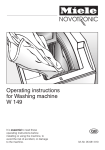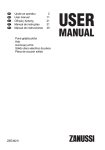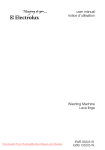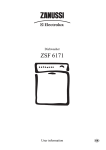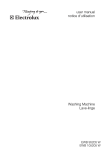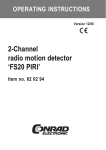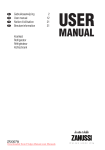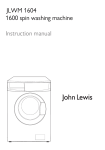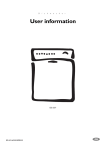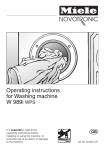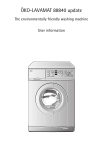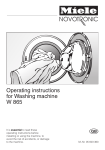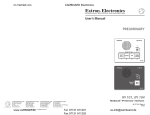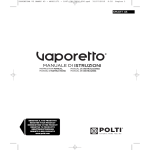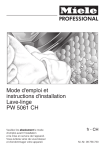Download Zanussi ZWQ 6120 User manual
Transcript
EN FR User manual Notice d'utilisation 2 14 Lave-linge ZWQ 6100 ZWQ 6120 Downloaded From WashingMachine-Manual.com Manuals Contents Safety information _ _ _ _ _ _ _ _ _ _ _ _ _ _ Product description _ _ _ _ _ _ _ _ _ _ _ _ _ Personalisation _ _ _ _ _ _ _ _ _ _ _ _ _ _ _ _ How to run a wash cycle? _ _ _ _ _ _ _ _ _ _ Daily Use _ _ _ _ _ _ _ _ _ _ _ _ _ _ _ _ _ _ _ Programmes table _ _ _ _ _ _ _ _ _ _ _ _ _ _ Care and cleaning _ _ _ _ _ _ _ _ _ _ _ _ _ _ 2 3 4 5 5 7 8 Operating Problems _ _ _ _ _ _ _ _ _ _ _ _ _ 9 Detergents and Additives _ _ _ _ _ _ _ _ _ _ 10 Technical Specifications _ _ _ _ _ _ _ _ _ _ 10 Consumption values _ _ _ _ _ _ _ _ _ _ _ _ 11 Installation _ _ _ _ _ _ _ _ _ _ _ _ _ _ _ _ _ _ 11 Environment _ _ _ _ _ _ _ _ _ _ _ _ _ _ _ _ _ 13 Subject to change without notice. Safety information Please read these points carefully before installing and using your appliance. Keep this user manual with your appliance. General safety • Do not modify or attempt to modify this appliance. This would put yourself in danger. • Ensure that all coins, safety pins, brooches, screws etc have been removed before starting a washing programme. If left in washing, they can seriously damage the appliance. • Use the recommended quantity of detergent. • Put small items together (socks, belts etc.) in a small linen bag or pillow case. • Unplug and close inlet hose tap after using appliance. • Always disconnect the power supply from the appliance before cleaning or maintenance. • Do not machine wash clothes with ribbing, unfinished or torn material. Installation • Unpack or ask for the appliance to be unpacked immediately upon delivery. Check the outside of the appliance is not damaged in any way. Report all transit damage to your retailer. • Remove all transit bolts and packaging before installing the appliance. • Connection to the water supply must be carried out by a qualified plumber. • If your domestic electrical circuit needs adapting to allow the appliance to be plugged in, use a qualified electrician. • Ensure that, after installation, the power cable is not trapped under the appliance. • If the appliance is installed on carpeted floor, ensure that the carpet does not obstruct any ventilation ducts located at the base of the appliance. • The appliance must be equipped with an earthed power plug which conforms to regulations. • Before connecting your appliance to the power supply, carefully read the instructions in the chapter entitled “Electrical connection”. • Replacing the power cable should only be carried out by an authorised service engineer. • The manufacturer cannot be held responsible for any damage resulting from incorrect installation. Precautions to be taken against frost If your appliance is exposed to temperatures below 0°C, the following precautions must be taken: • Close the tap and disconnect the inlet hose. • Place the end of this hose and the drain hose in a basin on the floor. • Select the Drain programme let it run until the end of the cycle. • Disconnect the appliance from the power supply by turning the programme selector to “Stop” . • Unplug the appliance. • Replace the inlet hose and drain hose. 2 Downloaded From WashingMachine-Manual.com Manuals www.zanussi.com This way, the water remaining in the hoses will be drained away, avoiding any ice formation which would damage your appliance. Before turning your appliance on again, ensure that it is installed in an area where the temperature will not fall below freezing. Use • Your appliance is intended for normal domestic use. Do not use the appliance for commercial or industrial purposes or for any other purpose. • Refer to the instructions on the label of each item before washing. • Do not put items into the washing machine which have had stains removed with petrol, alcohol, trichlorethylen etc. If such stain removers have been used, wait until the product has evaporated before putting these items into the drum. • Empty pockets and unfold items. • This appliance is not intended for use by persons (including children) with reduced physical, sensory or mental capabilities, or lack of experience and knowledge, unless they have been given supervision or instruction concerning use of the appliance by a person responsible for their safety. Children should be supervised to ensure that they do not play with the appliance. Product description 1 1. 2. 3. The control panel Lid handle Adjustable levelling feet 2 3 www.zanussi.com Downloaded From WashingMachine-Manual.com Manuals 3 The control panel 1 1. 2. 3. Programme selector Buttons and their functions Display 2 4. 5. 6. 3 4 5 6 "Door locked" light "Start/Pause" button "Delay start" button Dispenser box Prewash Wash Softener (do not fill above the MAX symbol M ) Personalisation Child safety This option provides two types of locking : • if the option is activated after the cycle has started, no changes to the options or programme is possible. The cycle runs and you must deactivate the option to run a new cycle. • if the option is activated before the cycle has started, the appliance cannot be started. To activate child safety, turn appliance on and and “Option” simultanepress “Spin” shows on ously until the confirmation symbol in the display. The appliance memorises the selection of this option. To deactivate child safety, repeat the process. 4 Downloaded From WashingMachine-Manual.com Manuals www.zanussi.com How to run a wash cycle? Using for the first time • Ensure the electrical and water connections comply with the installation instructions. • Remove the polystyrene insert and all other items inside the drum. • Run an initial wash cycle at 90°C, without any washing but with detergent to clean the water tank. Daily Use Loading washing • Open the lid of the appliance. • Open the drum by depressing the A locking button A: The two shutters unlock automatically. • Load the washing, close the drum and the lid of your washing machine. Warning! Before closing the lid of your appliance, ensure that the drum is properly closed : • When the two shutters are closed, • locking button A released. Proportioning of detergents Pour the amount of washing into the washing and prewash compartments if you have selected the “prewash” option. Pour fabric softener into the compartment if necessary. Selection of desired programme Turn the programme selector to the required pushbutton programme. The “Start/Pause” flashes green. If you turn the programme selector to another programme while a cycle is in progress, the appliance will ignore the new selected programme. “Err” flashes and the “Start/Pause” pushbutton flashes red for a few seconds. Selecting the spin speed for Cottons, Jeans : 1200 rpm (ZWQ 6120), 1000 rpm (ZWQ 6100), for Handwash, Wool : 1000 rpm (ZWQ 6100), 900 rpm (ZWQ 6120), for Synthetics, Sport : 900 rpm, for Delicates, Curtains : 700 rpm. Rinse hold By selecting this function the water of the last rinse is not emptied out to prevent the fabrics from creasing. At the end of the programme, if you have selec, you then need to select a ted “Rinse hold” or “Drain” programme to finish “Spin” the cycle and empty the water. Selecting options You must select the different options after selecting the programme and before pressing the pushbutton (see “Programme “Start/Pause” table”). Press the desired button(s) ; the corresponding lights come on. If pressed again, the lights go out. If one of the options is not compatible with the selected programme, “Err” flashes on the display and the “Start/Pause” pushbutton flashes red. “Prewash” option The appliance runs a prewash at 30°C max. “Quick” option The washing time will be reduced depending on the programme selected. “Economy” option This option allows you to choose a lower temperature programme which is as effective as a higher temperature wash programme. button to change the spin Press the “Spin” speed. The maximum spin speeds are : www.zanussi.com Downloaded From WashingMachine-Manual.com Manuals 5 “Easy iron” option If you select this option, the laundry is washed and spun delicately to prevent any creasing. This makes ironing easier. “Extra rinse” option The washing machine will add one or more rinses during the cycle. This option is recommended for people with sensitive skin and in soft water areas. button. Temporary : Press the “Extra rinse” The option is only active for the selected programme. and “ExPermanent : Hold down the “Eco” buttons for a few seconds. The tra rinse” option is permanently activated, even if the appliance is switched off. To deactivate it, repeat the process. “Delay start” This option allows you to delay the start of a wash programme by 30 minutes, 60 minutes, 90 minutes, 2 hours to 20 hours. The selected time appears on the display for a few seconds. You can change or cancel the delayed start time at any time before you press the “Start/ pushbutton, by pressing the “Delay Pause” pushbutton again ( ’ indicates imstart” mediate start). If you have already pressed the “Start/Pause” pushbutton and you want to change or cancel the delayed start, proceed as follows : • To cancel the delayed start and start the cyand cle immediately, press “Start/Pause” . Press “Start/Pause” then “Delay start” to start the cycle. • To change the timer delay period, you must go through the “Stop” position and reprogramme your cycle. The lid will be locked during the delayed start time. If you need to open it, you must first pause the appliance by pressing the “Start/Pause” pushbutton. After closing the lid again, press pushbutton. the “Start/Pause” Start of the programme pushbutton to start Press the “Start/Pause” the cycle ; the corresponding light will come on green. The indicator lights up (lid locked). It is normal for the programme selector to remain stationary during the cycle. The remaining time appears on the display. If a delayed start has been selected, the countdown appears on the display. Interrupting a programme Adding washing during the first 10 minutes light is off, you can add washing When the by proceeding as follows. Press the “Start/ pushbutton : the corresponding light Pause” will flash green while the appliance is paused. The lid can only be opened around 2 minutes after the washing machine has come to a stop. pushbutton again to Press the “Start/Pause” continue the programme. . Modifying the programme in progress Before making any changes to the current programme, you need to pause the washing mapushchine by pressing the “Start/Pause button. If the modification is not possible, “Err” flashes in the display and the “Start/Pause” pushbutton flashes red for a few seconds. If you still decide to change the programme, you must cancel the current programme (see below). . Cancelling the programme If you want to cancel the programme, turn the programme selector to the “Stop” position. End of the programme The washing machine stops automatically ; the pushbutton goes out and “Start/Pause” flashes on the display. The lid can only be opened around 2 minutes after the washing light (lid machine has come to a stop. The locked) is off. Turn the programme selector to the “Stop” position . Remove washing. Unplug and close water inlet tap. Stand by : once the programme has finished after a few minutes the energy saving system will be enabled. The brightness of the display is reduced. By pressing any button the appliance will come out of the energy saving status. 6 Downloaded From WashingMachine-Manual.com Manuals www.zanussi.com Programmes table Programme / Type of washing Load Available options 5,5 kg Rinse hold, Prewash, Quick2), Eco3), Easy iron, Extra rinse, Delay start Synthetics (30° - 60°) : Synthetic fabrics, body linen, coloured fabrics, non-iron shirts, blouses. 2,5 kg Rinse hold, Prewash, Quick2), Eco3), Easy iron, Extra rinse, Delay start Delicates (30° - 40°) : For all delicate materials, for example curtains. 2,5 kg Rinse hold, Prewash, Quick, Extra rinse, Delay start Wool (30° - 40°) : Machine washable wool carrying the labels “pure new wool, machine washable, does not shrink”. 1,0 kg Rinse hold, Delay start Handwash ( cold - 40°) : Very delicate items carrying the “wash by hand” label. 1,0 kg Rinse hold, Delay start Jeans (60°) : For washing denim clothes. The Extra rinse option is activated. 3,0 kg Rinse hold, Prewash, Easy iron, Delay start Sport (40°) : For very dirty outdoor sports clothes. The Prewash option is activated. 2,5 kg Rinse hold, Extra rinse, Delay start Curtains (40°) : For washing curtains. The Prewash option is activated. 2,5 kg Rinse hold, Extra rinse, Delay start Soak (30°) : 4) Soaking for very dirty washing. The drum stops full of water. 5,5 kg Delay start Rinses : Hand washed items can be rinsed in this programme. 5,5 kg Rinse hold, Easy iron, Extra rinse, Delay start Drain : Runs an empty cycle after a Rinse hold. 5,5 kg Spin : A spin cycle from 500 to 1200/10005) after a Rinse hold option. 5,5 kg Cottons1) (30° - 90°) : White or colour, e.g. normally soiled work clothes, bed linen, table linen, body linen, towels. Delay start 1) Standard programmes for the Energy Label consumption values According to regulation 1061/2010, the “Cottons 60 °C with Eco option” and “Cottons 40 °C with Eco option” are respectively the “standard 60 °C cotton programme” and the “standard 40 °C cotton programme”. They are the most efficient programmes in terms of combined energy and water consumptions for washing normally soiled cotton laundry. The water temperature of the washing phase may differ from the temperature declared for the selected programme. 2) Not available together with Eco option. 3) Not available with programmes with wash temperatures of 40°C and above. 4) Put the detergent into the compartment marked . 5) Depending on model. www.zanussi.com Downloaded From WashingMachine-Manual.com Manuals 7 Care and cleaning Unplug the appliance before cleaning. Descaling the appliance To descale the appliance, use an appropriate non-corrosive product designed for washing machines. Read product label for recommended amounts and how often descaling should be carried out. 8 7 9 10 CLACK The exterior Use warm soapy water to clean the exterior of the appliance. Never use alcohol, solvents or similar products. 11 Dispenser box To clean, proceed as follows : Water inlet filters To clean, proceed as follows : 3 1 CLACK 2 4 Drain filter Regularly clean the drain filter which is located at the bottom of the drum : 1 2 4 3 5 6 8 Downloaded From WashingMachine-Manual.com Manuals www.zanussi.com Operating Problems Numerous checks were carried out on your appliance before it left the factory. However, should you notice a malfunction, please refer to Problems the sections below before contacting the aftersales service. Causes The appliance doesn’t start or doesn’t fill : • the appliance isn’t plugged in correctly, the electrical installation isn’t working, there is a power failure, • the lid of your appliance and the drum shutters aren’t closed firmly, • the programme start command hasn’t been properly selected, • the water supply has been cut off, the water inlet tap is closed, • the water inlet filters are dirty (see “Care and cleaning”). The appliance fills but empties straight away : • the drainage U-piece is fixed too low (see “Installation”). The appliance doesn’t rinse or doesn’t empty : • the drain hose is blocked or bent, • the object trap is obstructed (see “Care and cleaning” ), • the out of balance detector has been activated : washing is unevenly distributed in the drum, • the “Drain” programme or “Night Cycle” or “Rinse hold” option have been selected, • the height of the drainage U-piece is unsuitable. The appliance doesn’t spin : • balance problem with the laundry load: add more laundry or manually adjust the items in the drum. You have found water around the appliance : • • • • too much detergent has caused foam to overflow, the detergent is unsuitable for machine washing, the drainage U-piece isn’t attached correctly, the water inlet hose is leaking. The washing results are not satisfactory : • • • • the detergent is unsuitable for machine washing, there is too much laundry in the drum, the wash cycle is unsuitable, there isn’t enough detergent. The appliance vibrates, is noisy : • • • • • all packaging have not been removed from the appliance (see “Installation” ), the appliance isn’t level and is unbalanced (see “Installation” ), the appliance is too close to the wall or furniture, washing is unevenly distributed in the drum, the load is too small. the appliance is in running in period, noise will disappear with time. The wash cycle is much too long : • • • • the water inlet filters are dirty (see “Care and cleaning”), the power or water supply has been cut off, the water inlet temperature is lower than usual, the foam detection security system has been activated (too much detergent) and the washing machine has begun draining the foam, • the out of balance detector has been activated: an extra phase has been added to distribute washing more evenly in the drum. www.zanussi.com Downloaded From WashingMachine-Manual.com Manuals 9 Problems Causes The appliance stops during • the water or electricity supply is defective, a wash cycle : • a “Rinse hold” option has been selected, • the drum shutters are open. The lid doesn’t open at the end of the cycle : • the temperature inside the drum is too high, • the lid unlocks 1 - 2 minutes after the end of the cycle. The error code appears in the display1) and the “Start/Pause” button flashes red 2) : • the lid is not closed properly. The error code appears in the display1) and the “Start/Pause” button flashes red2): • • • • • The error code appears in the display1) and the “Start/Pause” button flashes red2): • the water tap is closed, • the water supply has been cut off. Softener runs directly into the drum when filling the dispenser box: • you have gone past the MAX indicator. the object trap is obstructed, the drain hose is blocked or bent, the drain hose is fixed to high (see "Installation" ), the drainage pump is blocked, the standpipes are blocked. 1) On some models, the audible signals can sound 2) After solving any problems, press "Start/Pause" button to restart the interrupted programme. Detergents and Additives Only use detergents and additives designed for use in a washing machine. We do not recommend mixing different types of detergents. This may spoil the washing. There are no restrictions on the use of powder detergents. Liquid detergents must not be used when a prewash has been selected. For cycles without prewash, pour the liquid detergent directly into the drum or use a special dosing device (supplied by the detergent's manufacturer). Detergent tablets or doses must be placed in the detergent compartment of your appliance's dispenser box. Technical Specifications DIMENSIONS Height Width Depth 850 mm 400 mm 600 mm LINE VOLTAGE /FREQUENCY POWER CONSUMPTION FUSE 230 V / 50 Hz 2300 W 10 A Level of protection against ingress of solid particles and moisture IPX4 Water supply Cold water 10 Downloaded From WashingMachine-Manual.com Manuals www.zanussi.com WATER PRESSURE Minimum Maximum 0,05 MPa (0,5 bar) 0,8 MPa (8 bar) Connection to water supply Type 20/27 Consumption values The data of this table are approximate. Different causes can change the data: the quantity and type of laundry, the water and ambient temperature. Programmes Load (kg) Energy consumption (kWh) Water consumption (litre) Approximate programme duration (minutes) Remaining moisture (%)1) ZWQ 6100 Remaining moisture (%)1) ZWQ 6120 Cottons 60 °C 5,5 1.30 62 145 60 53 Cottons 40 °C 5,5 0.75 62 140 60 53 Synthetics 40 °C 2,5 0.65 48 80 37 35 Delicates 40 °C 2,5 0.55 53 70 37 35 Wool/Hand wash 30 °C 1 0.40 48 71 32 30 Standard cotton programmes Standard 60 °C cotton 5,5 0.96 53 213 60 53 Standard 60 °C cotton 2,5 0.79 35 165 60 53 Standard 40 °C cotton 2,5 0.59 35 130 60 53 1) At the end of spin phase. Off Mode (W) Left On Mode (W) 0.10 1.60 Installation Remove all protective packaging for transit before using for the first time. Keep in case needed for future transit: Transporting a non-secured appliance may damage internal components and cause leakages and malfunctions. The appliance can also be damaged through physical contact. Unpacking 1 2 www.zanussi.com Downloaded From WashingMachine-Manual.com Manuals 1 2 11 Water supply 1 90O 2 Untying A B A C D 2 B 1 B 2 1 D Keep the transit bolts for when you move the appliance. To install the appliance at the same level as neighboring furniture, cut these plastic pieces. In case of necessity move the inlet hose in the direction shown on picture. To make this loose the inlet hose ring nut and position the inlet hose downwards as drawn on picture. Tighten the ring nut back and make sure there are no leaks. Open the water inlet tap. Check there are no leaks. The water inlet hose can not be extended. If it is too short, please contact the after-sales service. Drainage Fit the U-piece on the drainage hose. Place everything in a drainage point (or in a sink) at a min max 70 cm 100 cm height of between 70 and 100 cm. Ensure it is positioned securely. Air must be able to enter the end of the hose, to avoid any risk of siphoning. The drain hose must never be stretched. If it is too short, contact an engineer. Electrical connection This washing machine must only be connected in single-phased 230 V. Check the fuse size: 10 A for 230 V. The appliance must not be connected with an extension lead or multi-plug adaptor. Ensure that the plug is earthed and that it is in accordance with current regulations. Positioning Position the appliance on a flat and hard surface in a ventilated location. Ensure the appliance does not come into contact with the wall or other furniture. Accurate levelling avoids viwww.zanussi.com 12 Downloaded From WashingMachine-Manual.com Manuals brations, noise and prevents the appliance from moving when running. Environment Disposing of the appliance All materials carrying the symbol are recyclable. Dispose of them at a waste collection site (enquire at your local council) for collection and recycling. When disposing of your appliance, remove all parts which could be dangerous to others: cut off the power supply cable at the base of the appliance. on the product or on its packagThe symbol ing indicates that this product may not be treated as household waste. Instead it should be taken to the appropriate collection point for the recycling of electrical and electronic equipment. By ensuring this product is disposed of correctly, you will help prevent potential negative consequences for the environment and human health, which could otherwise be caused by in- appropriate waste handling of this product. For more detailed information about recycling of this product, please contact your local council, your household waste disposal service or the shop where you purchased the product. Protecting the environment To save water and energy and therefore help protect the environment, we recommend the following: • Whenever possible, use the appliance at full capacity and avoid partial loads. • Only use the prewash and soak programmes for heavily soiled items. • Use an appropriate amount of detergent for the hardness of the water, the size of the load and how soiled the washing is. www.zanussi.com Downloaded From WashingMachine-Manual.com Manuals 13 Sommaire Consignes de sécurité _ _ _ _ _ _ _ _ _ _ _ Description de l'appareil _ _ _ _ _ _ _ _ _ _ Personnalisation _ _ _ _ _ _ _ _ _ _ _ _ _ _ _ Comment effectuer un cycle de lavage ? _ Utilisation quotidienne _ _ _ _ _ _ _ _ _ _ _ Tableau des programmes _ _ _ _ _ _ _ _ _ _ Entretien et nettoyage _ _ _ _ _ _ _ _ _ _ _ 14 15 16 17 17 19 20 Problèmes de fonctionnement _ _ _ _ _ _ _ Produits de lavage et additifs _ _ _ _ _ _ _ _ Caractéristiques techniques _ _ _ _ _ _ _ _ Valeurs de consommation _ _ _ _ _ _ _ _ _ Installation _ _ _ _ _ _ _ _ _ _ _ _ _ _ _ _ _ _ Environnement _ _ _ _ _ _ _ _ _ _ _ _ _ _ _ 21 23 23 23 24 26 Sous réserve de modifications. Consignes de sécurité Veuillez lire attentivement ces remarques avant d’installer et d’utiliser votre appareil. Conservez ce manuel à proximité de l'appareil. Consignes générales de sécurité • Ne tentez pas de modifier l'appareil. Cela serait dangereux pour vous. • Avant de lancer un programme de lavage, vérifiez que toutes les broches de sécurité, vis, etc. ont été retirées. En effet, si ces éléments se trouvaient accidentellement dans le lavelinge, cela risquerait d'endommager gravement l'appareil. • Veillez à utiliser la quantité de lessive recommandée. • Regroupez les articles de petite taille (chaussettes, ceintures, etc.) au sein d'un linge ou d'une taie d'oreiller. • Après toute utilisation, débranchez l'appareil et fermez le rabat du tuyau d'arrivée d'eau. • Vous devez systématiquement débrancher l'appareil avant tout nettoyage ou opération de maintenance. • Ne lavez pas à la machine des vêtements contenant des rubans ou du tissu torsadé. Installation • Déballez ou faites déballer l'appareil dès sa livraison. Vérifiez que les parois extérieures de l'appareil ne sont pas endommagées. En cas de dommage occasionné par le transport, signalez-le au vendeur. • Retirez toutes les attaches de transport avant d'installer l'appareil. • Le raccordement à l'arrivée d'eau doit être effectué par un plombier qualifié. • Si votre installation électrique nécessite une adaptation en vue du branchement de l'appareil, faites appel à un électricien qualifié. • Après l'installation, vérifiez que le câble d'alimentation n'est pas bloqué sous l'appareil. • Si l'appareil est installé sur un tapis, assurezvous que celui-ci n'obstrue pas les tuyaux de ventilation situés au bas de l'appareil. • L'appareil doit être équipé d'une prise mise à la terre conforme à la réglementation en vigueur. • Avant de brancher l'appareil, lisez attentivement les instructions fournies dans le chapitre consacré au branchement électrique. • Le remplacement du câble d'alimentation ne doit être effectué que par un technicien de maintenance habilité. • Le fabricant ne pourra en aucun cas être tenu responsable des dommages résultant d'une installation incorrecte. Précautions à prendre contre le gel Si votre appareil est exposé à des températures inférieures à 0 °C, prenez les précautions suivantes : • Fermez le rabat et débranchez le tuyau d'arrivée d'eau. • Placez l'extrémité de ce tuyau, ainsi que le tuyau de vidange, dans une cuvette posée sur le sol. • Sélectionnez le programme de vidange et laissez-le s'exécuter jusqu'à la fin. 14 Downloaded From WashingMachine-Manual.com Manuals www.zanussi.com • Coupez l'alimentation de l'appareil en positionnant le sélecteur de programmes sur Arrêt. . • Débranchez l’appareil. • Remettez en place le tuyau d'arrivée d'eau et le tuyau de vidange. Cela permet à l'eau restant dans les tuyaux d'être vidangée, ce qui évite toute formation de glace qui risquerait d'endommager l'appareil. Avant de remettre l'appareil en marche, vérifiez qu'il est installé dans une zone non exposée au gel. Utilisation • Votre appareil est destiné à un usage domestique normal. N'utilisez pas cet appareil à des fins commerciales ou industrielles ou pour d'autres usages. • Avant le lavage, consultez les instructions d'entretien de chaque article (vêtement). • N'insérez pas dans le lave-linge des articles détachés à l'aide d'alcool, de tricholréthylène, etc. Si des détachants de ce type ont été utilisés, attendez l'évaporation totale de ce produit avant de placer les articles dans le tambour. • Videz les poches des vêtements et dépliezles. • Cet appareil n’est pas destiné à être utilisé par des enfants ou des personnes dont les capacités physiques, sensorielles ou mentales, ou le manque d'expérience et de connaissances les empêchent d'utiliser l'appareil sans risque lorsqu'ils sont sans surveillance ou en l'absence d'instructions d'une personne responsable qui puisse leur assurer une utilisation de l'appareil sans danger. Veillez à ce que les enfants ne jouent pas avec l'appareil. Description de l'appareil 1 1. 2. 3. Bandeau de commande Poignée de couvercle Pieds de mise à niveau 2 3 www.zanussi.com Downloaded From WashingMachine-Manual.com Manuals 15 Bandeau de commande 1 1. 2. 3. Sélecteur de programmes Touches et leurs fonctions Affichage 2 4. 5. 6. 3 4 5 6 Voyant « Porte fermée » Touche « Départ/Pause » Touche « Départ différé » Réservoir Prélavage Lavage Assouplissant (veillez à ne pas dépasser le niveau indiqué par le repère MAX M ) Personnalisation Sécurité enfants Cette option propose deux types de verrouillage : • si l'option est activée après le départ du cycle, aucune modification ne peut être apportée aux options ou au programme. Le cycle se déroule et vous devez désactiver l'option pour lancer un nouveau cycle. • Si l'option est activée avant le départ du cycle, l'appareil ne peut pas être mis en fonctionnement. Pour activer la sécurité enfants, mettez l'appareil en fonctionnement et appuyez simultanéet « Opment sur les touches « Essorage » jusqu'à ce que le symbole de confirtion » s'affiche. L'appareil mémorise le mation choix de cette option. Pour désactiver la sécurité enfants, répétez la procédure. 16 Downloaded From WashingMachine-Manual.com Manuals www.zanussi.com Comment effectuer un cycle de lavage ? Première utilisation • Assurez-vous que les raccordements électriques et hydrauliques sont conformes aux instructions d'installation. • Retirez les éléments en polystyrène et tout autre élément figurant dans le tambour. • Effectuez un premier cycle de lavage à vide à 90 °C, avec lessive pour nettoyer le réservoir d'eau. Utilisation quotidienne Chargement du linge • Ouvrez le couvercle de l'appareil. • Ouvrez le tambour en appuyant sur la A touche A : les deux portillons s'ouvrent automatiquement. • Chargez le linge, puis fermez le tambour et le couvercle de votre lave-linge. Avertissement Avant de fermer le couvercle de l'appareil, vérifiez que le tambour a été correctement fermé : • une fois que les deux portillons sont fermés, • la touche A est libérée. Quantité de lessive Versez la quantité de détergent nécessaire et de dans les compartiments de lavage si vous avez sélectionné l'option prélavage « Prélavage ». Versez l'assouplissant dans le compartiment , si nécessaire. Sélection du programme Tournez le sélecteur de programmes sur le programme choisi. La touche MARCHE/ARRET clignote en vert. Si vous tournez le sélecteur de programmes pour choisir un autre programme alors qu'un cycle est en cours, le lave-linge ne prend pas en compte le nouveau programme sélectionné. Err s'affiche puis clignote, et la touche MARclignote en rouge pendant CHE/ARRET quelques secondes. Choix de la vitesse d'essorage Appuyez sur la touche « Essorage » pour modifier la vitesse d'essorage. Les vitesses d'essorage maximales sont les suivantes : pour Coton et Jeans : 1 200 tr/min (ZWQ 6120), 1 000 tr/min (ZWQ 6100) ; pour Lavage à la main, Laine : 1 000 tr/min (ZWQ 6100), 900 tr/min (ZWQ 6120) ; pour Synthétiques, Sport : 900 tr/min ; pour Tissus délicats, Rideaux : 700 tr/min. Arrêt cuve pleine Lorsque vous choisissez cette option, l’eau du dernier rinçage n'est pas évacuée pour éviter le froissage du linge. À la fin du programme, si vous avez sélectionné , vous devez sélection« Arrêt cuve pleine » ou de vidanner un programme d'essorage afin de terminer le cycle et vider l'eau. ge Choix des options Après la sélection d'un programme, vous devez choisir les options correspondantes avant d'ap(repuyer sur la touche MARCHE/ARRET portez-vous au tableau des programmes). Appuyez sur les touches souhaitées : les voyants correspondants s'allument. Si vous appuyez une deuxième fois, les voyants s'éteignent. Si aucune des options n'est compatible avec le programme sélectionné, les lettes Err clignotent clignote en et la touche MARCHE/ARRET rouge. Option PRELAVAGE L'appareil effectue un prélavage à une température maximale de 30 °C. www.zanussi.com Downloaded From WashingMachine-Manual.com Manuals 17 Option RAPIDE La durée de lavage est réduite, en fonction du programme sélectionné. Option « Économie » Cette option permet de choisir un programme utilisant une température inférieure, mais aussi efficace que le programme utilisant une température plus élevée. Option FACILE A REPASSER Si vous sélectionnez cette option, le linge est lavé et essoré délicatement, afin d'éviter les plis sur le linge. Cela facilite le repassage. Option « Rinçage plus » Un ou plusieurs rinçages sont ajoutés au cours du cycle. Cette option est recommandée pour les personnes à la peau sensible et dans les régions où l'eau ne présente pas un niveau élevé de dureté. Temporaire : Appuyez sur la touche « Rinçage . L'option est uniquement active pour plus » le programme sélectionné. Permanent : Maintenez appuyées pendant quelques secondes les touches « Éco » et . L'option est alors activée « Rinçage plus » de manière permanente, même si l'appareil est arrêté. Pour la désactiver, répétez la procédure. Option DEPART DIFFERE Cette option vous permet de retarder le départ d'un programme de lavage de 30, 60, 90 minutes, 2 heures à 20 heures. La durée sélectionnée reste affichée pendant quelques secondes. Vous pouvez modifier ou annuler le départ différé à tout moment avant d'appuyer sur la tou, en appuyant à nouche « Départ/Pause » ( ’ veau sur la touche « Départ différé » indique un départ immédiat). Si vous avez déjà appuyé sur la touche MARet que vous souhaitez modifier CHE/ARRET ou annuler le départ différé, procédez comme suit : • Pour annuler le départ différé et démarrer immédiatement le cycle, appuyez sur la touche , puis sur la touche de MARCHE/ARRET . Appuyez sur la touche départ différé pour lancer le cycle. MARCHE/ARRET • Pour modifier le délai du départ différé, vous devez repasser par la position ARRÊT et reprogrammer le cycle. Le couvercle est verrouillé pendant le temps du départ différé. Si vous devez l'ouvrir, vous devez au préalable mettre l'appareil en pause : pour cela, appuyez sur la touche MARCHE/ARRET . Après avoir refermé le couvercle, appuyez sur la touche MARCHE/ARRÊT . Départ du programme Appuyez sur la touche « Départ/Pause » pour lancer le cycle ; le voyant correspondant s'allume en vert. Le voyant s'allume (couvercle verrouillé). Il est normal que le sélecteur de programme demeure immobile pendant le cycle. La durée restante s'affiche. Si un départ différé a été sélectionné, le décompte s'affiche. Interruption d'un programme Ajout de linge pendant les 10 premières minutes s'éteint, vous pouvez Lorsque le voyant ajouter le linge en procédant comme suit : Ap: le puyez sur la touche MARCHE/ARRET voyant correspondant clignote en vert pendant que l'appareil est en mode Pause. Le couvercle ne peut être ouvert qu'environ 2 minutes après l'arrêt du lave-linge. Appuyez de nouveau sur la pour continuer le touche MARCHE/ARRET programme. . Modification du programme en cours d'exécution Avant d'effectuer toute modification du programme en cours, vous devez mettre le lave-linge en mode Pause : appuyez sur la touche . Si cette modification est MARCHE/ARRET impossible, les lettes Err clignotent et la touche clignote en rouge penMARCHE/ARRET dant quelques secondes. Si vous souhaitez malgré tout modifier le programme, vous devez préalablement annuler le programme en cours (voir ci-après). . Annulation du programme Si vous désirez annuler un programme, tournez la manette du sélecteur de programmes sur la position Arrêt . 18 Downloaded From WashingMachine-Manual.com Manuals www.zanussi.com Fin du programme Le lave-linge s'arrête automatiquement ; la tous'éteint et clignote che « Départ/Pause » sur l'affichage. Le capot ne peut être ouvert qu'environ 2 minutes après l'arrêt du lave-linge. (couvercle verrouillé) est éteint. Le voyant Tournez le sélecteur de programme sur la posi- tion « Arrêt » . Retirez le linge. Débranchez l'appareil et fermez le robinet d'arrivée d'eau. Mode Veille : une fois le programme terminé, le système d'économie d'énergie s'active au bout de quelques minutes. La luminosité de l'écran est réduite. Pour sortir du mode d'économie d'énergie, il suffit d'appuyer sur n'importe quelle touche de l'appareil. Tableau des programmes Programme / Type de lavage Charge Options disponibles 5,5 kg Arrêt cuve pleine, Prélavage, Rapide2), Éco3), Repassage facile, Rinçage plus, Départ différé Synthétiques (30° - 60°) : Textiles synthétiques, linge de corps, textiles de couleur, chemises sans repassage, chemisiers. 2,5 kg Arrêt cuve pleine, Prélavage, Rapide2), Éco3), Repassage facile, Rinçage plus, Départ différé Textiles délicats (30° - 40°) : Pour tous les textiles délicats, par exemple les rideaux. 2,5 kg Arrêt cuve pleine, Prélavage, Rapide, Rinçage plus, Départ différé Laine (30° - 40°) : Articles en laine lavables en machine portant les étiquettes « pure laine vierge, lavable en machine, ne rétrécit pas ». 1,0 kg Arrêt cuve pleine, Départ différé Lavage à la main ( froid - 40°) : Articles très délicats portant une étiquette « lavage à la main ». 1,0 kg Arrêt cuve pleine, Départ différé Jeans (60°) : Pour le lavage des vêtements en jean. L'option Rinçage plus est activée. 3,0 kg Arrêt cuve pleine, Prélavage, Repassage facile, Départ différé Sport (40°) : Pour les vêtements de sport très sales. L'option Prélavage est activée. 2,5 kg Arrêt cuve pleine, Rinçage plus, Départ différé Rideaux (40°) : Pour le lavage des rideaux. L'option Prélavage est activée. 2,5 kg Arrêt cuve pleine, Rinçage plus, Départ différé Trempage (30°) : 4) Trempage des vêtements très sales. Le tambour s'arrête cuve pleine. 5,5 kg Départ différé Rinçages : Ce programme permet de rincer des articles lavés à la main. 5,5 kg Arrêt cuve pleine, Repassage facile, Rinçage plus, Départ différé Vidange : Exécute un cycle de vidange après un arrêt cuve pleine. 5,5 kg Coton1) (30° - 90°) : Blancs ou couleurs normalement sales, notamment les vêtements de travail, le linge de lit, le linge de table, le linge de corps et les serviettes de toilette. www.zanussi.com Downloaded From WashingMachine-Manual.com Manuals 19 Programme / Type de lavage Charge Essorage : Un cycle d'essorage de 500 à 1 200/1 000 tr/min5) après un arrêt cuve pleine. 5,5 kg Options disponibles Départ différé 1) Programmes standard pour les valeurs de consommation de l'étiquette énergétique Conformément à la norme 1061/2010, les programmes « Coton 60 °C avec option Éco » et « Coton 40 °C avec option Éco » sont respectivement le « programme standard à 60 °C pour le coton » et le « programme standard à 40 °C pour le coton ». Ce sont les programmes les plus économes en termes de consommation d'eau et d'électricité pour laver du linge en coton normalement sale. La température de l'eau de la phase de lavage peut différer de la température indiquée pour le programme sélectionné. 2) Non disponible en combinaison avec l'option Éco. 3) Non disponible pour les programmes avec des températures de lavage supérieures ou égales à 40 °C. 4) Mettez le produit de lavage dans le compartiment indiqué par . 5) En fonction du modèle de l'appareil. Entretien et nettoyage Débranchez l’appareil avant de le nettoyer. Détartrage de l’appareil Pour détartrer l'appareil, utilisez un produit non corrosif conçu pour les lave-linge. Lisez attentivement l'étiquette (quantités recommandées et fréquence du détartrage). Parois extérieures Pour nettoyer les parois extérieures de l'appareil, utilisez de l'eau chaude savonneuse. N'utilisez jamais d'alcool, de produits abrasifs ou caustiques. 1 2 4 3 5 6 Réservoir Pour le nettoyage, procédez comme suit : 3 1 2 4 Filtre de vidange Nettoyez régulièrement le filtre de vidange situé dans le fond du tambour : 20 Downloaded From WashingMachine-Manual.com Manuals www.zanussi.com Filtres de l'arrivée d'eau Pour le nettoyage, procédez comme suit : 8 7 9 10 CLACK 11 CLACK Problèmes de fonctionnement De nombreux contrôles ont été effectués sur l'appareil avant le départ de l'usine. Toutefois, en cas de dysfonctionnement, reportez-vous aux paragraphes ci-dessous avant de contacter le service après-vente. Problèmes Causes L'appareil ne démarre pas ou ne se remplit pas : • l'appareil n'est pas branché correctement, l'installation électrique ne fonctionne pas, une panne de courant s'est produite, • le couvercle et le tambour de l'appareil ne sont pas fermés correctement, • la commande de départ programme n'a pas été correctement sélectionnée, • l'arrivée d'eau a été coupée, le robinet d'arrivée d'eau est fermé, • les filtres d'arrivée d'eau sont encrassés (reportez-vous au paragraphe « Entretien et nettoyage »). L'appareil se remplit d'eau mais vidange immédiatement : • la pièce de vidange en forme de U est fixée trop bas (reportez-vous au chapitre « Installation »). L'appareil ne rince pas ou ne se vide pas : • le tuyau de vidange est bloqué ou déformé, • le filtre de vidange est obstrué (reportez-vous au chapitre « Entretien et nettoyage »), • la sécurité anti-balourd a été activée : le linge n'est pas réparti de façon uniforme dans le tambour, • le programme de « vidange » ou les options « Nuit Silence Plus » ou « Arrêt cuve pleine » ont été sélectionnés, • la taille (hauteur) de la pièce de vidange en forme de U est inappropriée. L'appareil n'essore pas : • problème d'équilibrage de la charge de linge : ajoutez du linge ou répartissez manuellement les articles dans le tambour. Il y a de l'eau autour de l'appareil : • • • • une trop grande quantité de lessive a entraîné un débordement de mousse, la lessive utilisée n'est pas adaptée au lavage en machine, la pièce de vidange en forme de U n'est pas correctement fixée, le tuyau d'arrivée d'eau fuit. www.zanussi.com Downloaded From WashingMachine-Manual.com Manuals 21 Problèmes Causes Les résultats du lavage ne sont pas satisfaisants : • • • • la lessive utilisée n'est pas adaptée au lavage en machine, vous avez introduit trop de linge dans le tambour, le cycle de lavage sélectionné n'est pas approprié, la quantité de lessive est insuffisante. L'appareil vibre bruyamment : • vous n'avez pas retiré tout l'emballage de l'appareil (reportez-vous au chapitre « Installation »), • l'appareil n'est pas à niveau et est déséquilibré (reportez-vous au chapitre « Installation »), • l'appareil est installé trop près du mur ou d'un meuble, • le linge n'est pas réparti de façon uniforme dans le tambour, la charge est trop faible, • l'appareil est neuf, le bruit va disparaître progressivement. Le cycle de lavage est beaucoup trop long : • les filtres d'arrivée d'eau sont encrassés (reportez-vous au paragraphe « Entretien et nettoyage »), • l'alimentation électrique ou l'arrivée d'eau ont été coupées, • la température d'arrivée d'eau est inférieure à la normale, • le système de sécurité de détection de mousse a été activé (trop de lessive) et le lave-linge vidange l'excès de mousse, • la sécurité anti-balourd a été activée : une phase a été ajoutée pour mieux répartir le linge dans le tambour. L'appareil se met à l'arrêt au cours d'un cycle de lavage : • l'alimentation électrique ou l'arrivée d'eau sont défectueuses, • l'option « Arrêt cuve pleine » a été sélectionnée, • le tambour est ouvert. Le couvercle ne s'ouvre pas en fin de cycle • la température à l'intérieur du tambour est trop élevée, • le couvercle se déverrouille 1 à 2 minutes après la fin du cycle. Le code d'erreur s'affiche1) et la touche « Départ/Pause » clignote en rouge. 2) : • le couvercle n'est pas correctement fermé. Le code d'erreur s'affiche1) et la touche « Départ/Pause » clignote en rouge2) : • le collecteur d'objets est obstrué, • le tuyau de vidange est bloqué ou déformé, • le tuyau de vidange est fixé trop haut (reportez-vous au chapitre « Installation »), • la pompe de vidange est bloquée, • les tuyaux d'évacuation sont bloqués. Le code d'erreur s'affiche1) et la touche « Départ/Pause » clignote en rouge2) : • le robinet d'arrivée d'eau est fermé, • l'arrivée d'eau a été fermée. 22 Downloaded From WashingMachine-Manual.com Manuals www.zanussi.com Problèmes Causes L'assouplissant s'écoule directement dans le tambour lorsque vous remplissez le réservoir correspondant : • vous avez dépassé la quantité maximale représentée par l'indicateur MAX. 1) Sur certains modèles, des signaux sonores peuvent retentir 2) Après la résolution du problème, appuyez sur la touche « Départ/Pause » pour relancer le programme interrompu. Produits de lavage et additifs Veillez à utiliser uniquement des produits de lavage et des additifs conçus pour les lave-linge. Le mélange de différents types de produits de lavage n'est pas recommandé. Cela risquerait d'endommager le linge. L'utilisation de produits de lavage en poudre ne fait l'objet d'aucune restriction. Les produits de lavage liquides ne doivent pas être utilisés lorsqu'un programme de prélavage a été sélectionné. Pour les cycles sans prélavage, versez le produit de lavage liquide directement dans le tambour ou utilisez une doseuse spéciale (fournie par le fabricant du produit de lavage). Les tablettes ou doses de produits de lavage doivent être placées dans la boîte à produits de l'appareil. Caractéristiques techniques DIMENSIONS Height Width Depth 850 mm 400 mm 600 mm LINE VOLTAGE /FREQUENCY POWER CONSUMPTION FUSE 230 V / 50 Hz 2300 W 10 A Level of protection against ingress of solid particles and moisture IPX4 Water supply Cold water WATER PRESSURE Minimum Maximum 0,05 MPa (0,5 bar) 0,8 MPa (8 bar) Connection to water supply Type 20/27 Valeurs de consommation The data of this table are approximate. Different causes can change the data: the quantity and type of laundry, the water and ambient temperature. Programmes Load (kg) Energy consumption (kWh) Water consumption (litre) Approximate programme duration (minutes) Remaining moisture (%)1) ZWQ 6100 Remaining moisture (%)1) ZWQ 6120 Cottons 60 °C 5,5 1.30 62 145 60 53 www.zanussi.com Downloaded From WashingMachine-Manual.com Manuals 23 Programmes Load (kg) Energy consumption (kWh) Water consumption (litre) Approximate programme duration (minutes) Remaining moisture (%)1) ZWQ 6100 Remaining moisture (%)1) ZWQ 6120 Cottons 40 °C 5,5 0.75 62 140 60 53 Synthetics 40 °C 2,5 0.65 48 80 37 35 Delicates 40 °C 2,5 0.55 53 70 37 35 Wool/Hand wash 30 °C 1 0.40 48 71 32 30 Standard cotton programmes Standard 60 °C cotton 5,5 0.96 53 213 60 53 Standard 60 °C cotton 2,5 0.79 35 165 60 53 Standard 40 °C cotton 2,5 0.59 35 130 60 53 1) At the end of spin phase. Off Mode (W) Left On Mode (W) 0.10 1.60 Installation Avant la première utilisation, retirez tous les emballages utilisés pour le transport. Conservezles en cas de déplacement ultérieur. En effet, le transport d'un appareil non sécurisé risque d'endommager les composants internes et d'entraîner fuites et mauvais fonctionnements. Le contact physique peut également entraîner une déterioration de l'appareil. 2 Mise à niveau Déballage 1 2 1 1 2 A B A C D 24 Downloaded From WashingMachine-Manual.com Manuals www.zanussi.com 2 B 1 B 2 1 D Conservez les boulons de transport, ils devront être remontés pour tout autre transport de l'appareil. Pour que l'appareil soit aligné aux meubles voisins, découpez ces pièces en plastique. Branchement électrique This washing machine must only be connected in single-phased 230 V. Check the fuse size: 10 A for 230 V. The appliance must not be connected with an extension lead or multi-plug adaptor. Ensure that the plug is earthed and that it is in accordance with current regulations. Emplacement Placez l'appareil sur une surface plane et dure dans un endroit bien ventilé. Veillez à ce que l'appareil ne soit pas en contact avec le mur ou avec d'autres meubles. Une mise à niveau précise permet d'éviter les vibrations, le bruit et empêche l'appareil de se déplacer au cours de son fonctionnement. Arrivée d'eau 90O Si cela est nécessaire, déplacez le tuyau d'arrivée dans le sens indiqué sur l'image. À cet effet, desserrez la bague de serrage et positionnez le tuyau d'arrivée vers le bas comme illustré sur l'image. Resserrez la bague et assurezvous qu'il n'y a aucune fuite. Vidange Fixez la pièce de vidange (U) sur le tuyau de vidange. Regroupez les différents éléments au min max 70 cm 100 cm sein d'un point de vidange, à une hauteur comprise entre 70 et 100 cm. Vérifiez qu'il est correctement positionné. L'air doit pouvoir pénétrer au bout du tuyau, afin d'éviter tout risque de siphonage. Le tuyau de vidange ne doit pas être plié. S'il est trop court, contactez un professionnel spécialisé. Ouvrez le robinet d'arrivée d'eau. Assurez-vous de l'absence de fuite. Le tuyau d'arrivée d'eau ne peut pas être rallongé. S'il est trop court, contactez votre service après-vente. www.zanussi.com Downloaded From WashingMachine-Manual.com Manuals 25 Environnement Mise au rebut de l'appareil Tous les matériaux marqués par le symbosont recyclables. Pour leur mise au le rebut, déposez-les sur un site de collecte et de recyclage de déchets (pour en connaître l'adresse, contactez votre mairie). Lorsque vous mettez au rebut l'appareil, retirez tous les composants qui risqueraient d'être dangereux ; sectionnez le câble d'alimentation situé à la base de l'appareil. qui figure sur le produit ou son Le symbole emballage indique que ce produit ne peut être traité comme déchet ménager. Il doit être remis à un point de collecte et de recyclage du matériel électrique et électronique. En éliminant l'appareil comme il se doit, l'utilisateur contribue à atténuer les conséquences négatives qu'une mauvaise gestion des déchets de ce produit peut avoir sur l'environnement et la santé. Pour obtenir plus de détails sur le recyclage de ce produit, veuillez prendre contact avec les services de votre commune ou le magasin où vous avez effectué l'achat. Protection de l’environnement Pour économiser de l'eau et de l'énergie (et donc contribuer à protéger l'environnement), nous vous recommandons : • d'utiliser l'appareil à sa capacité maximale dans la mesure du possible, et d'éviter les charges partielles ; • de réserver les programmes Prélavage et Trempage aux vêtements extrêmement sales ; • d'utiliser la quantité de détergent appropriée à la dureté de l'eau, à la charge et au niveau de saleté des vêtements. 26 Downloaded From WashingMachine-Manual.com Manuals www.zanussi.com www.zanussi.com Downloaded From WashingMachine-Manual.com Manuals 27 Downloaded From WashingMachine-Manual.com Manuals 192989523-A-092012 www.zanussi.com/shop
This document in other languages
- français: Zanussi ZWQ 6120































